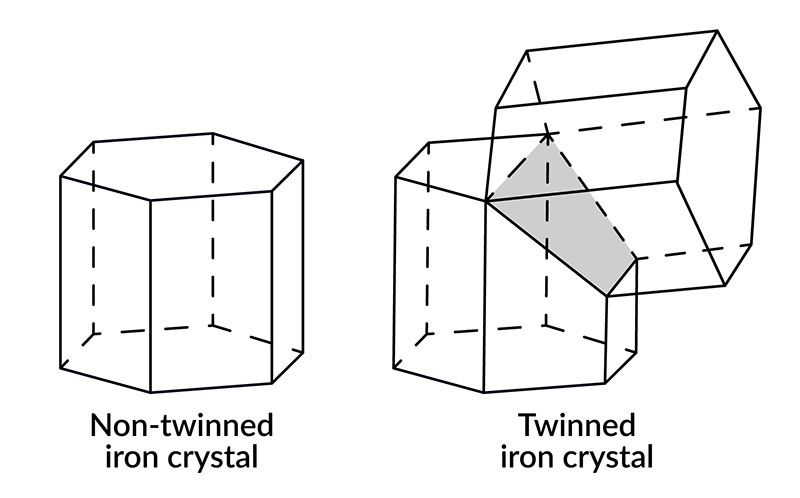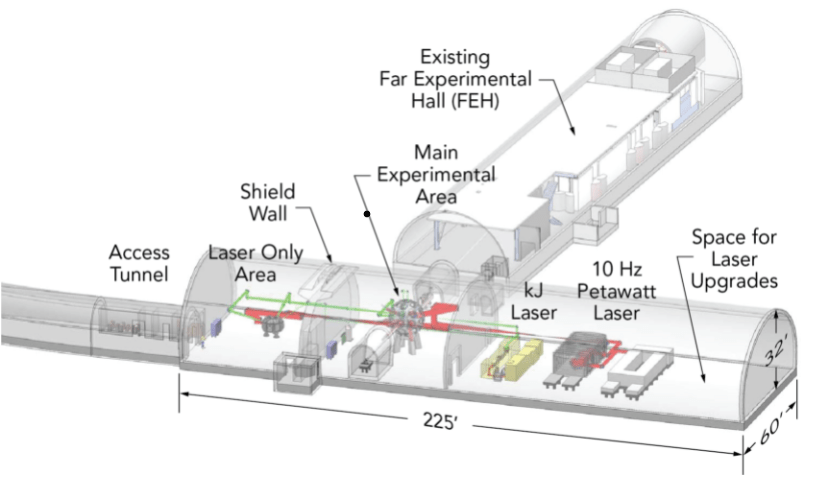It’s one of nature’s topsy-turvy tricks that the deep interior of the Earth is as hot as the Sun’s surface. The sphere of iron that resides there is also under extreme pressure: about 360 million times more pressure than we experience on the Earth’s surface. But how can scientists study what happens to the iron at the center of the Earth when it’s largely unobservable?
With a pair of lasers.
Earth is not the only body with an iron core. Mercury, Venus, and Mars have them, too. In fact, any world that was ever molten is likely to have an iron core, since iron’s density makes it fall toward the center of a world’s gravity. Astronomers think that some iron asteroids are actually cores from planetesimals that lost the rest of their mass due to collisions.
What happens to the iron when two planets collide? What happens to the iron at the Earth’s core? In both scenarios, the iron is subjected to extreme heat and pressure. Most of what scientists do know about iron in these extreme conditions comes from laboratory experiments involving lesser temperatures and pressures. But researchers at the DOE’s SLAC (Stanford Linear Accelerator Center) wanted to recreate the extremes at the Earth’s center as best they could to test iron’s behaviour.
The researchers, led by Sébastien Merkel of the Université de Lille, published a paper reporting their findings. The paper’s title is “Femtosecond Visualization of hcp-Iron Strength and Plasticity under Shock Compression” and it’s published in the journal Physical Review Letters.
Under normal conditions on the Earth’s surface, iron is arranged a certain way naturally. The atoms are arranged in nanoscopic cubes, with an iron atom in the center and one at each corner. When under sufficiently high pressure, the irons rearrange into hexagonal prisms. That configuration allows more iron to be compressed into the same space.
 When under sufficient pressure iron forms hexagonal prisms. Image Credit: S. Merkel/University of Lille, France
When under sufficient pressure iron forms hexagonal prisms. Image Credit: S. Merkel/University of Lille, FranceThis much is already known.
But what happens when the pressure is increased even further, to the same levels as the Earth’s outer core? To find out, the team of researchers used two lasers.
The first laser was an optical laser used to induce a shock wave that subjected the iron in the lab to extreme temperatures and pressures. The second laser was SLAC’s Linac Coherent Light Source (LCLS) X-ray free-electron laser. The LCLS allowed the team to observe the iron on an atomic level as it was subjected to extreme conditions.
“We didn’t quite make inner core conditions,” says co-author Arianna Gleason, a scientist in the High-Energy Density Science (HEDS) Division at SLAC. “But we achieved the conditions of the outer core of the planet, which is really remarkable.”
Other materials like quartz, titanium, zircon, and calcite have been tested in similar ways. But nobody had ever observed iron under such extreme temperature and pressure.
“As we continue to push it, the iron doesn’t know what to do with this extra stress,” says Gleason. “And it needs to relieve that stress, so it tries to find the most efficient mechanism to do that.”
In response to all that stress, the iron does something called “twinning.”
“We were able to make a measurement in a billionth of a second. Freezing the atoms where they are in that nanosecond is really exciting.”
Twinning is when atoms rearrange themselves so that they share crystal lattice points symmetrically. Different materials exhibit different types of twinning, all governed by well-understood laws. In iron’s case, the hexagonal prisms rotate to the side nearly 90 degrees. The point of attachment is called the twin plane or the compositional surface.
When iron twins like this, it becomes extraordinarily strong. At first. But as time goes on, that strength disappears.
“Twinning allows iron to be incredibly strong — stronger than we first thought — before it starts to flow plastically on much longer time scales,” Gleason said.
This discovery revolved around a sample of iron the size of a strand of human hair. The iron was shocked by the optical laser into extreme heat and pressure. In a press release, lead author Sébastien Merkel described what it was like during the experiments. “The control room is just above the experimental room,” he said. “When you trigger the discharge, you hear a loud pop.”
Then the LCLS observed the iron’s reaction in nanosecond scales to see how the atoms rearranged themselves. Prior to the experiment, the team didn’t know how fast the iron would respond and if they’d be able to measure the changes. “We were able to make a measurement in a billionth of a second,” co-author Gleason said. “Freezing the atoms where they are in that nanosecond is really exciting.”
The team’s results were highlighted by an editor at Physical Review Letters. In a comment, the corresponding editor Merric Stephens said, “Initially, the shock wave changed the iron’s structure from body-centered-cubic to hexagonal-close-packed, something the team expected to happen. The hexagonal structure then deformed elastically for several nanoseconds before yielding, after which it accommodated strain by rearranging itself into pairs of twinned crystals—a process that continued even after the stress had fallen below the yield stress.”
According to the researchers, just being able to measure changes that happen so fast is a successful result in itself. “The fact that the twinning happens on the time scale that we can measure it as an important result in itself,” Merkel said.
Prior to this experiment, much of our understanding of iron comes from observing the element under less extreme conditions then modelling it forward, to higher extremes. But these results are an important step forward.
“Now we can give a thumbs up, thumbs down on some of the physics models for really fundamental deformation mechanisms,” Gleason says. “That helps to build up some of the predictive capability we’re lacking for modelling how materials respond at extreme conditions.”
Gleason says that the newly-upgraded LCLS allowed this experiment to come to fruition, and will lead to more. “The future is bright now that we’ve developed a way to make these measurements,” Gleason says. “The recent X-ray undulator upgrade as part of the LCLS-II project allows higher X-ray energies — enabling studies on thicker alloys and materials that have lower symmetry and more complex X-ray fingerprints.”
This experiment produced results nobody had ever observed before. But even with the success, the team wasn’t able to duplicate the extreme conditions at the Earth’s inner core. They were only able to duplicate the outer core. But in the future, that’ll change.
“… we’re going to get more powerful optical lasers with the approval to proceed with a new flagship petawatt laser facility, known as MEC-U,” says Gleason. “That’ll make future work even more exciting because we’ll be able to get to the Earth’s inner core conditions without any problem.”
The new laser will be housed in an underground facility connected to SLAC’s existing LCLS. The petawatt laser will produce a million billion watts and will be able to study materials in the most extreme environments imaginable. The Matter in Extreme Conditions Upgrade (MEC-U) “… promises to dramatically improve our understanding of the conditions needed to produce fusion energy and to replicate a wide range of astrophysical phenomena here on Earth,” according to the Department of Energy.
 In a new underground experimental facility coupled to SLAC’s Linac Coherent Light Source (LCLS), two state-of-the-art laser systems – a high-power petawatt laser and a high-energy kilojoule laser – will feed into two new experimental areas dedicated to the study of hot dense plasmas, astrophysics, and planetary science. (Gilliss Dyer/SLAC National Accelerator Laboratory)
In a new underground experimental facility coupled to SLAC’s Linac Coherent Light Source (LCLS), two state-of-the-art laser systems – a high-power petawatt laser and a high-energy kilojoule laser – will feed into two new experimental areas dedicated to the study of hot dense plasmas, astrophysics, and planetary science. (Gilliss Dyer/SLAC National Accelerator Laboratory)There’s been plenty of thinking and theorizing about the state of iron in the extreme conditions at the Earth’s core. Scientists surmised that twinning would take place, as it does for other materials, but weren’t certain. Now there’s experimental data to support some of that thinking and to disprove other conclusions.

